September 21st, 2010 · No Comments
I’ve been trying very hard not to compare London with New York, and failing miserably. But I think that this is one topic on which I may be excused – Broadway vs. West End. As a native New Yorker, and someone fortunate enough to have seen a number of Broadway shows, I must admit to a certain bias. However, almost all of the shows that I have seen in London have been wonderful productions. The Merry Wives of Windsor at Shakespeare’s Globe, though painful due to standing for two hours, was definitely a unique experience. You can’t get quite the same feel in the states – it doesn’t feel as genuine. Les Misérables and 39 Steps were also very well done, offering two of my favorite things – music and comedy. I even enjoyed The Habit of Art, a more serious drama than I am usually partial to. Not only were each of the productions well executed technically, but I thought the actual acting, the conveying of emotion was phenomenal.
However, not every performance I attended left me with the same impression, and I’m afraid that one really bad experience has tipped the scale in Broadway’s favor. I think almost everyone in our program has heard of the great theatre debacle by now. If you haven’t, here’s a quick rundown: Mel, Dan and I went to see a show in the West End. I cannot reveal which show because we all decided that it was just too horrible to mention by name ever again. However, I can describe what was so terribly bad about it. Perhaps what I found most frustrating was that the show had such potential. The plotline allowed for many opportunities of real dance numbers. Instead we got the same exact choreography again and again, song after song. Usually in a musical, dance numbers also have singing. Again we were disappointed. Most, if not all of the songs were played from a soundtrack with the performers occasionally singing some obnoxiously loud misplaced note. And now we discuss the acting. To be fair, they really didn’t have much to work with, but even a high school student could have done a better job of conveying emotion. I suppose there was attempted humor, but the jokes were not funny and even if they had been, the lines were delivered without much enthusiasm.
Tags: 2010 Sarah
September 21st, 2010 · No Comments
As a young American, it is really hard to find a good pub in London. And I’ve tried. We’ve all had the experience of going into a pub and being told that it’s not open, despite the fact that there are still a lot of people sitting at tables, some even being served at that moment. And, no matter how early pubs close in London, 9:42 is not a believable closing time.
Jesse, Emily, and I were discussing why we thought pubs would tell us they close so early. Don’t they want our business? The answer, of course, seems to be dependent on who we are. If we- a crowd of excited, loud Americans- go into an already full pub in Bloomsbury, the bartender doesn’t necessarily want to bother with the hassle. In groups, we can be very noisy, and the fact that sometimes we want to order separately doesn’t seem to help our cause. If just a few of us walk quietly into a relatively empty pub at quarter to 11, they are much more likely to serve us, despite the late hour. Recently the three of us were looking for a pub in the neighborhood, even though it was nearly 11, and The Jack Horner of Tottenham Court seemed to be open. Even though it was late, we had the best service I’ve had at a pub. They were friendly, attentive, and even apologetic when they told us (at 11:17) that they were closing, even though we had already been warned. We even got a “good night” from them, something I have definitely never heard from a bartender at a pub before.
I suppose that different areas have different “pub rules,” if you will. Bartenders in Covent Garden, for example, expect all sorts of rowdy customers at all hours of the night. A pub I went to in Covent Garden, for example, was completely packed at 11 one night, and the clientele made no indication that they were about to leave anytime soon. And the bartenders didn’t really seem to mind. In Bloomsbury, though, where the customers generally seem to be upper-middleclass businessmen and regulars who are all relatively quiet, the bartenders don’t exactly look happy to see us when we walk in.
Since I haven’t seen many people my age in pubs, though, I wonder how much of it is that we are young and how much of it is that we are Americans. I think this would be an interesting theory to test. I suppose, in Norwich, it will be easier to tell if we really are being snubbed for being loud Americans or if it is our age group that is less appealing to the pub staff.
On a slightly different note, I would have to agree with George Orwell when he says that it is “the atmosphere” that really distinguishes pubs. I, for example, much prefer quieter, well-lit pubs (like The Jack Horner), where I can sit down and enjoy a pint rather than the more rowdy, crowded pubs (like The Court, for example), where people seem to be drinking their ales (and shots) as fast as they can. What I will call the “college atmosphere” of crowded, dark pubs is all well and good some of the time, but other times I just want to relax.
Tags: 2010 Jessica
September 21st, 2010 · No Comments
Whenever I see green it makes me so happy. I guess it has a lot to do with the fact that I grew up in really big city, so I didn’t get to see green on a regular basis. In Brooklyn, a park consists of a playground set, and a basketball court. You might get the occasional tennis or handball court, but as far as endless acres of green land…dream on! I would have never expected London to have so much green area being a highly developed, bustling city…but I was so wrong. London is so beautiful, which is another reason why I love it here. There is a balance between man made and nature, and while it is nice to live the city life, it is also necessary to get away sometimes and just take a stroll in the park, and not just Central Park (angry New Yorker), but have a variety of great parks to chose from. Not only are the parks beautiful, they are also so clean and well maintained! You can tell that residents respect the parks here and abide by the rules of sanitation. There are even “dog waste only” rubbish bins scattered around the parks, something that is definitely needed back in the states.

My favorite park would have to be Regents Park. In addition to its endless seas of green, I really loved the Queen’s Rose Garden. I don’t understand why flowers make girls so happy, but they give me a warm fuzzy feeling inside that I can’t explain (LOL). Sarah and I lost all concept of time as we wondered through the garden, mesmerized by roses of all different colors, shapes, and sizes. There was also a pond, and a waterfall, and couples smooching everywhere, which made us gag, but I guess one would say that the garden set the scene for a romantic getaway. Other than the rat that we saw running through the flowerbeds, it was perfect. It was great to see a very diverse crowd enjoying the afternoon in the park. I saw all races, and ages, laying in the grass, playing games, or just strolling along the walkway. I guess enjoying the afternoon in a park, surrounded by green, is something that almost everyone shares in common. If you don’t like parks, then I guess your just weird.

Tags: 2010 Melissa
September 21st, 2010 · 4 Comments
Maybe my perceptions are a bit skewed coming from Southern California – where it has been illegal to smoke in restaurants the longest and anyone who lights up is shot death glares from everyone within a ten-mile radius- but it seems to me that number of people who smoke in London is drastically higher than in the States.
I’ve lost count of the number of times I’ve been walking down the street only to have the person in front or to the side of me exhale their smoke directly into my path. I’ve had cigarette butts almost land on me as a smoker tosses it away multiple times. Again, maybe I’m particularly sensitive to this- not just because I come from California, but because I had severe asthma as a child, still am highly allergic to cigarette smoke, AND my mother spent almost 10 years teaching tobacco and drug education in the California public schools. So, I think it’s fair to say I’m pretty aware of smoking.
I’m making no personal judgements on smokers, but I just don’t understand how it can be so much more rampant here. At first I reasoned that maybe the UK’s tobacco education programs (if they have them at all) aren’t as widespread as they are in the States and California in particular but then I happened to notice the label on a discarded pack of ciggies, which looked a little something like this:
 [Photo: http://www.tobaccoonline.co.uk/images/products/1217200833339AMSobranie-Cocktail-cigarette.png]
[Photo: http://www.tobaccoonline.co.uk/images/products/1217200833339AMSobranie-Cocktail-cigarette.png]
I don’t make a habit of checking cigarette pack warning labels in the US, but I’m pretty sure that our warning labels use much smaller print and read something along the lines of: WARNING- cigarettes have been known to cause cancer and certain birth defects. But, no- the Brits put it right out there in big bold print- SMOKING KILLS. So why does such what seems to be a huge percent of London’s population continue to do it? There is a very weird disconnect here . . .
I actually did some research on this and, according to the London Health Observatory, “About 10 million adults in Great Britain smoke cigarettes – 23% of men and 21% of women” (http://www.lho.org.uk/LHO_Topics/National_Lead_Areas/Smoking.aspx#Smoking). However, data from the 2008 General Lifestyle Survey showed that, compared to other regions of England, London doesn’t actually have that high a percentage of smokers:
“The regions of England with the highest prevalence were the North West, and Yorkshire and the Humber, where 23 to 25 per cent of people were cigarette smokers (similar to the level in Scotland). The prevalence of cigarette smoking was lowest, at 19 per cent, in the East of England and in London”- http://www.statistics.gov.uk/downloads/theme_compendia/GLF08/GLFSmoking&DrinkingAmongAdults2008.pdf
I’m not trying to make a particular point here or offer any words of wisdom for London or Great Britain as a whole- I’m truthfully just amazed at how many people seem to smoke here. Looking at the statistics, though, makes it seem like London isn’t really that much of a smoker’s city.
So, I guess, what I’m asking is, what have been everyone else’s experiences? Am I just uber-sensitive? Are the statistics plain wrong? Maybe a little of both? Whatever the case may be, I really wish Londoners would stop blowing their smoke wherever they please and be a little more conscientious- some of us have delicate lungs! *cough*
Tags: 2010 Elizabeth
September 21st, 2010 · No Comments
Perhaps I should begin by writing about how different they are from what I expected. First of all, London is supposed to be this big hoppin’ city with a fantastic nightlife. Wrong. Almost every pub we tried the first two weeks we were here closes at eleven o’clock – weekends included. When the first bartender told us, I didn’t believe it was true. I thought they were just trying to get rid of the annoying American kids that don’t know how to order a pint. But then I started to realize that everyone in the pub was leaving and it was the same for each of the pubs we visited after that, so it couldn’t be simply a conspiracy against obnoxious students. My next reaction was annoyance and frustration. What kind of city closes at eleven?
I also expected that the music selection would be a little bit different. My assumption was that a British establishment would play British or at least European music. Wrong again. As Mel’s post pointed out, pubs here play mostly American music. During the course of an evening one may hear Justin Timberlake, R. Kelly, Journey, Lady Gaga….and the occasional Beatles song (but let’s face it, we have Americanized the Beatles to the point where we have adopted them as our own). I am really disappointed that I haven’t heard any new songs yet. Has American pop music become a British norm? Hopefully once we get up to Norwich and out of such a touristy area we will encounter a more diverse and authentic British sound.
One of the things we learned from Kate Fox is that pubs are one of those bizarre exception places where British people are allowed to be friendly if they want to. This is perhaps the only one where my expectations have held true. I assumed both from reading Kate Fox and from my own social instincts that although no one would approach me, if I instigated a conversation people would generally respond warmly. My first experiment: the bartenders. Almost every one of them has been friendly. No one has made fun of my accent, or my inability to sort through the ridiculous multitude of coins which any British child of five could handle. My next victims were the actual pub goers, and it seems that the same rules apply. One night at The Court, a couple of us wanted to play pool but we weren’t sure what the etiquette was for queuing or why table seemed to have different dimensions than the ones we are used to back home. The group of British kids that were already playing were happy enough to explain to us that the table is smaller because it wasn’t actually meant for billiards but a different type of game. While we waited for our turn a few of them continued to talk to us providing us with little helpful tips and tidbits of information.
All in all, I’d say that the pubs have been a mixed experience. I think that after I get over the initial shock of early closings, I could really learn to enjoy them.
Tags: 2010 Sarah
September 21st, 2010 · No Comments
I’ve really enjoyed the religion component to this course. Although I don’t believe in organized religion, I’ve never dismissed knowledge about other religious customs and beliefs. However, when visiting famous sites like The Westminster Abbey and St. Paul’s Cathedral, which do attract large masses of tourists, I felt as if I was in a museum rather than a place of worship. Westminster Abbey did have the occasional moments of silence for visitors to remember that it was a religious establishment, however I still didn’t really feel the connection. While I do understand that of course, these beautifully crafted structures are world renowned, if I was religious I would feel a little uncomfortable with a church being more of an attraction than anything else. Visiting St. Paul’s and Westminster did not provide me with any religious education however, when I visited Bath Abbey they did hand out pamphlets that highlighted the importance of God in our lives and bible scriptures, which I appreciated and thought that the other establishments could have done the same.
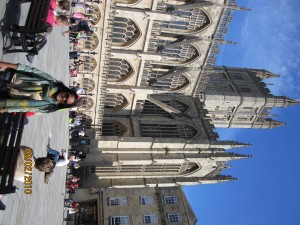
My favorite visits were to the Hindu mandir and the Islamic mosque because I really gained valuable knowledge. Although the mandir also seemed like a tourist attraction, in addition to showing off the intricate details of their temple, they also made efforts to teach the public about their beliefs with providing the exhibition on Hinduism. The mosque wasn’t touristy, but our guide was helpful in explaining his religion and did his best to make connections between what we already knew and contrasted his views to some of our own religions. What I enjoyed hearing about the most was how involved these establishments were in their communities. I think it is great that they participate with people of other faith to reach out and service the community. The mosque’s involvement in TELCO (The East London Communities Organization), which has a commitment to “working together for common good and changing the way politics happen in London”, was one of the many ways that they contributed to their neighborhood.
I found the guide of the mosque to be the most interesting out of all of our visits because he shared something that I have never a representative of any religion say; he admitted that his people suffered from a lack of knowledge about other people’s faith. He shared that there are some people who think they know all there is to know and don’t seek additional knowledge and in his opinion this contributes greatly to the barrier between the Islamic people and the rest of the world. His honesty was admirable and I strongly agreed with him. Something as small as seeking basic understanding of other peoples and religions really can go as far as changing the world one day.
Tags: 2010 Melissa
September 21st, 2010 · No Comments
It took me quite a while to get around to investigating the parks in London. I think most of this is because I had already been to Hyde Park when I was younger (i.e. less interested in such things) and because I was trying to go to so many museums and city-related destinations that I didn’t really think I had the time. Another unconscious reason, I suppose, is that, while I do love Central Park, I just didn’t really think that parks in the middle of a city would be much to write home about. But I was wrong.
While getting caught up in the crowds and the bustle of the city, I completely forgot to, literally, stop and smell the roses- if you’ll forgive the pun. I know everyone I spoke to on the subject had the same experience, but it truly is amazing to walk a few minutes away from the city and find yourself completely surrounded by green. Kaitlin and I decided to get some take away from Harrod’s and bring it to Hyde Park to eat, and we walked straight out of the city and into the rose gardens. (First we had to pass a horse riding trail. It was amazing!) Once you travel farther into the park, it’s even easier to forget that Harrod’s and Knightsbridge are only a few kilometers away.
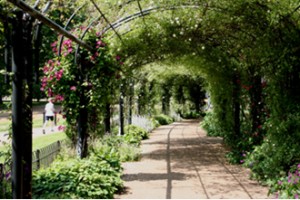
Hyde Park Rose Garden (courtesy of GardenVisit.com)
Hyde Park – photo courtesy of GardenVisit.com
And Regent’s Park, that’s another story entirely. We got off the tube, walked down an upper class residential street, and wound up in what seemed like an entirely different part of the country. With playgrounds, huge green fields, trees, ponds, rose gardens, and high hedges, it is entirely possible to forget that you are in a huge, busy city.
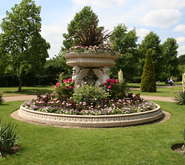
Regent’s Park – photo courtesy of GardenVisit.com
I know it sounds pretty cliché, but it really was fantastic to get back in touch with nature after so seeing much brick and stone day after day. I could have sat and watched the swans swim and stare at the flowers all day. Unfortunately I was only able to spend a few hours in the parks, but it was an amazing diversion from busy city life. And today at Hampstead Heath was completely gorgeous. Some of the girls and I had to take the time to frolic through the fields because we’ve missed nature so much.
Even though I initially dismissed the importance of the parks in London, I loved seeing so much green in the middle of the buildings. And because there aren’t so many skyscrapers in London, it was much easier than expected to forget I was in the city at all. No traffic noise, no pollution, no impatient drivers or pedestrians; just nature, for as far as I could see.
Tags: 2010 Jessica
September 21st, 2010 · 1 Comment
It seems like everyone I talked to in our program strongly disliked the Victoria and Albert Museum. I don’t know what they were thinking, because I thought it was one of the most amazing places I have ever been. I loved how random it was – it really epitomized British eccentricity. The V & A seemed to be completely lacking in order from one room to the next, whereas other museums that we have been to, like the British Museum or the London Museum seem to be arranged more logically. But I really like how chaotic it was. It added the element of surprise which made me laugh aloud. I think the key is to go in with a game plan. Know which exhibits you want to see beforehand, that way you organize your visit accordingly. Any interesting sites you find along the way can just be a fun little bonus.
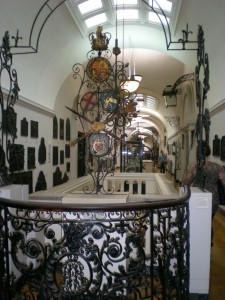
So what was the most interesting part of such a fascinatingly bizarre place? No, not the jewelry, although my eyes were glued to several dazzling tiaras, but what I found most intriguing was being able to watch the museum staff put together an exhibit. I felt like I was backstage at a play, watching the people who work behind the scenes. I never realized how much work it would take to create even just one exhibit. There were at least ten or fifteen people working on the room. Some were doing physical work, lifting and moving planks of wood, while others looked over papers on clipboards and directed traffic. However, I was a bit mystified because I didn’t know what it was exactly that they were building and I still don’t know what it had to do with that particular room of the museum. It just looked like they were plonking down a big ol’ wall in the middle of the room. And as far as I could tell there were no signs posted anywhere with “coming soon” information, so I’ll just have to make another trip back to London in a few months to see what it looks like.
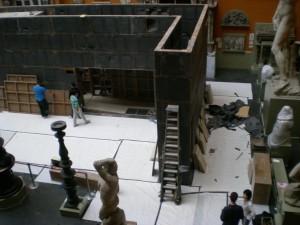
I also got really excited when I saw the piece by Dale Chihuly. The artist is known for his work with glass, creating huge and intricate structures. I was fortunate enough to be able to see his exhibit back home at the Botanical Gardens in New York with my family, and so when I recognized his work in the V&A, it was like seeing a little piece of home.

This is a piece at the Victoria and Albert Museum
Here’s one from home:
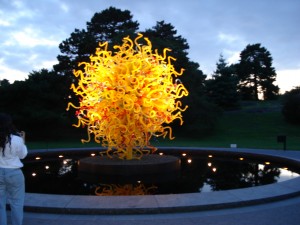
Tags: 2010 Sarah
September 21st, 2010 · No Comments
From what I’ve begun to gather, the English (or, Londoners) aren’t particularly fond the French or French culture. I overheard a conversation on the street that ended in, “Do I look bloody French to you?”. Not quite sure of the motivation behind the outburst, but anti-French sentiment, while not rampant, is a visible part of popular English culture. It’s strange, then, that some of London’s most prominent physical elements should mesh so completely with the French formal ideal: parks.
The classic French conception of beauty in nature is that none can exist without the existence of order- of the human hand altering the chaotic natural mass into a structured, geometric product. From what I’ve seen of the layout of Regent’s park, the Brits have just about the same idea. Many people have commented that parks in London seem to be, first and foremost, places to enjoy the beauty of the precisely-planned horticulture. We see meticulously trimmed hedges, flowers planted with regard to color scheme, and white fountains as centerpieces. While running in Regent’s the other afternoon, I saw teams of gardeners replacing soil and adjusting flowerbeds. The beauty lies not only in pure nature, but in the reordering and distribution of it.

http://www.gardens-to-visit.com/2009/02/versailles-2.html
It’s hard to think of a better example of this systematic restructuring than in Versailles. The hedges are pruned to an almost impossible degree of uniformity, the flowers are separated with care, and there are man made monuments throughout (to serve as an even more solid testament to the strength and genius of the designers. The same artistic values and technical skill are visible in Queen Mary’s Garden in Regent’s park.
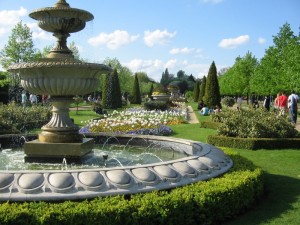
http://www.londonrelocationservices.com/blog/tag/west-london-relocation
The rows and rows of flowers in the garden do not grow in natural patterns, as might be typical in American parks or gardens. Like their French counterparts, the English gardeners have devised color schemes, strict rows, and tight upkeep standards on all the elements of the space (note the uniformity in the hedges around the fountain and the flower patches). These areas of the park are not meant for “fun” in the typical American park sense of the word- we were glared at for tossing a frisbee in the garden a few days ago. They’re a medium of artistic expression, and I’m starting to appreciate them more and more. I do think, however, that instead of badmouthing the French, Londoners should take some time to stop and smell the roses. It’s through these gardens that we can see real, fundamental similarities in an important aspect of the two cultures.
Tags: 2010 Patrick · Uncategorized
September 21st, 2010 · No Comments
The parks of London provide a natural respite from the busy, hectic, and stressful atmosphere of the city. Once in them, you are enveloped by a green tranquil, unable to hear the bustle of cars and people outside the parks’ confines. I have personally experienced this phenomenon at several parks, ranging from Regent’s park (where I ran for the first time since surgery! not a bad debut location), Hyde Park, and most others. This type of division between hustle-bustle and repose mirrors the separation of work and play that Fox often talks about.
However, there is also a clear division within the park of activities that mirrors this division of social and work life. There are areas for sitting contemplatively in very silly chairs, which you are supposedly required to pay for. There are areas for looking at quite nice fountains, sculptures, or gardens. Then there are designated areas for sports, with soccer nets and rugby… posts? Tennis courts seem a bit necessary to be fenced off for convenience’s sake. Several little cafés are sprinkled throughout the parks as well.
Regent’s park matches the above description. I’ve made several trips to this park to run, play a bit of ultimate, have a cup of coffee, or just stroll around and look at the great horticulture. However, all of these activities would occur in different locations in the actual park. This segments the activities, and consequently divides the people that enjoy different forms of recreation. Personally, it made me very uneasy. If I were to throw a disc in the wrong area, I risked getting publicly reprimanded (as classmates have experienced). Anyway – it would take quite a bit of time for me to analyze this division (and I really don’t have the experience or expertise to do so) but there has to be some sociological effect. If you have thoughts on this, just comment on this post.
However, not all parks match this model. St. Jame’s park, home of many venereal diseases during the restoration period, per Dennis’ description, is seemingly built for nothing but comfort and relaxing. There are nice little walks along the lake, a couple bridges, some out-of-place fowl, and many large grassy areas upon which you can sit. However, in a couple walks through the park, I never saw anyone playing catch, football, or any other sport in these large areas. Though it was suspiciously absent of proper monuments (at least, I didn’t see many), the website is careful to highlight the pelican feeding from 2:30-3, and the deck-chairs. Weird. More leisure activities. I should note that there is a quite disproportionately small playground for children. However, as a whole, this is not a built-for-fun park. It is a built-for-relaxing-park, and I think is such because of its close proximity to Buckingham Palace. Green Park, also bordering Buckingham Palace, mirrors this model of relaxation, rather than recreational, with a few monuments (such as the Canada memorial), and is a bit more open green spaces rather than pathways-and-lakes. To me, these two parks are just not okay. I envision parks as a place where you can run around, play whatever kind of games you want. Having fancy gardens in parks just seems to counteract this.
Hyde park, the last park I will discuss in this post, blends athletics and relaxation much like Regent’s. And, just like Regent’s, different activities are segmented. There are different areas for sitting in lawn chairs, areas for tennis, I’ve seen people playing soccer on some of the larger fields (quite far away from the chairs, mind you), and the notorious Speaker’s Corner, completely ostracized from any central location. I suspect that its location is completely intentional whatever authority governs the parks wanted to make sure the… colorful characters that frequent the corner would not pollute (in their mind) the rest of the park.
Well, the parks are divided not only from the city but often divided within themselves. What effect this has on the psyche of park attendees, I’m not sure. Though I love the idea of having large parks in cities, I don’t like this division. If you want to have fancy gardens, just don’t call the whole thing a park.

 That these two photos (both personal) came from the same park (Regent’s) makes little sense to me (though the picture from the right, in my opinion, should not even come from a park).
That these two photos (both personal) came from the same park (Regent’s) makes little sense to me (though the picture from the right, in my opinion, should not even come from a park).
Tags: 2010 ChristopherB



 [Photo: http://www.tobaccoonline.co.uk/images/products/1217200833339AMSobranie-Cocktail-cigarette.png]
[Photo: http://www.tobaccoonline.co.uk/images/products/1217200833339AMSobranie-Cocktail-cigarette.png]









